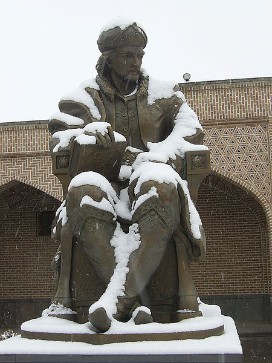 Calligraphic representation of Ali, the First Imam of Shia Islam
Calligraphic representation of Ali, the First Imam of Shia Islam
Six Charts that Explain Shia Islam
With the recent advance of the Sunni-extremist group ISIS and the increasing sectarian divisions that are cleaving apart the Islamic world, it is more important than ever to understand the differences and similarities between distinct Muslim groups, particularly Sunnis and Shia. With such an understanding, citizens and policy-makers can make more effective decisions and accurate judgements in assessing the current situation in Iraq, predicting possible outcomes, and devising solutions.
Background and History

Statue of Shah Ismail in Ardabil, Iran, Courtesy of Ashena Iran
The Shia branch of Islam primarily differs from the Sunni branch in that it emphasizes the authority of Muhammad’s descendants as leaders of the international Muslim community, which the Shia call Imams, rather than Muhammad’s companions and their successors.
Generally, the sects of Shia Islam differ from one another in the number of Imams they recognize to be legitimate, who they recognize those Imams to be, and what role those Imams possess.
Most Shia sects share the first four Imams: 1) Ali ibn Abu Talib, 2) Hassan ibn Ali, 3) Husayn ibn Ali, and 4) Zayn al-Abidin. The Twelvers, Alevis, and Alawites have 12 Imams; the Zaidis have 5; and each Ismaili sect has 7. Twelvers believe that the 12th and final Imam Muhammad al-Mahdi underwent a period of occultation and will remain hidden from the world until the Day of Judgement when he will return to help redeem the world from sin.
The death of the third imam Husayn at the hands of the Umayyad caliph Yazid I on the battlefields of Karbala, Iraq is a particularly important event for Shia Muslims and is commemorated by the holiday The Day of Ashura.
Throughout history, different regimes have instituted Shia Islam as the official religion, the most important of which for the identity of modern Shi’ites was the reign of Shah Ismail I in the early 16th century Safavid Empire who instituted Twelver Shia Islam as Iran’s official religion. Since then, Twelver Shia Islam has grown to be the largest branch of Shia Islam and Iran has become the center of the Shia Muslim world.
Six Charts that Explain Shia Islam
These six charts give a compelling account of where Shia Muslims live and how they understand the world. Explore the Shia Muslim world by scrolling over these interactive charts. Only countries with Shia populations in excess of 100,000 are featured on the maps.
Percentage of Shia Among the World Muslim Population
Main Takeaways: Sunni Islam is the sect of the majority of Muslims while Shia Islam is the second largest with approximately 10 – 13% of the world Muslim population.
Percentage of Shia Out of Total Muslim Population By Country
Main Takeaways: Generally, the countries with the most solidly Shia populations are located near the Iranian plateau, the eastern coast of the Mediterranean, the Persian Gulf, and the south-western corner of the Arabian peninsula.
Countries With the Highest Percentage of Shia
Main Takeaways: The countries with the most solidly Shia populations are: (1) Iran, (2) Azerbaijan, (3) Bahrain, (4) Iraq, and (5) Lebanon.
Size of Shia Population By Country
Main Takeaways: Generally, the countries with the largest Shia populations are located near the Iranian plateau, southern Asia, the south-western corner of the Arabian peninsula, and Turkey.
Countries With the Largest Shia Populations
Main Takeaways: The countries with the largest Shia populations are: (1) Iran, (2) Pakistan, (3) Iraq, (4) India, and (5) Yemen.
Dominant Shia Sect In Each Country
Main Takeaways: Twelver Shia is the dominant Shia sect in most countries where Shia are present, but there are notable exceptions. In Syria, the Alawites are the dominant Shia sect, in Yemen, the Zaidis are the dominant Shia sect, and, in Turkey, Alevis are the dominant Shia sect. Sevener Shia, or Ismailis, constitute a significant minority in Iran, Afghanistan, Pakistan, and India, but do not form a majority in any country.
Calligraphic representation of Ali, the First Imam of Shia Islam, Courtesy of Petermaleh.






[…] Six Charts that Explain Shia Islam […]
Hi,
You stated the following:”Iraq is a particularly important event for Shia Muslims and is commemorated by the holiday The Day of Ashura.”
In reference to commemoration it is the tragical memorium that extends for ten days from the first of Muharram, the first lunar calendar, till the tenth, so it is actually not one day. Thank you for your bringing up such an issue and many thanks for your attention.
Best regards,